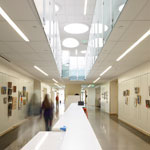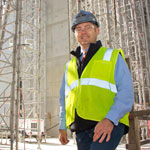At a Glance
Company headquarters
San Francisco
Design department employees
Approx. 50 globally
Average project duration
12 months
Current locations
Approx. 3,800
A few years ago, when Levi Strauss & Co. bought back its substantial fleet of outlet stores from the franchisee who’d started them, director of store design Michael Williams knew he had some work ahead of him. Basically, as he saw it, his company had inherited a jumble of stores with no consistency or brand identity, so he and his team immediately set about cultivating a sense of uniformity. “Over the last two years, we have taken many paths to clarify our outlet-store experience by focusing on fundamental program requirements: fixtures and finishes, smarter graphics, sustainability, merchandising, and value-engineering the format to increase brand equity,” he says. “The result has been amazing. With a less-is-more approach, we created an intuitive shopping experience that accurately represents the Levi’s outlet store.”
Now, with such measures substantially in place, Williams and his design team have pushed themselves even further, recently conceiving a more premium outlet experience called Outlet 2.0. “This concept takes the outlet format as far as it can go before becoming a full-price environment, with the best lighting and finishes we could design with the limited budget,” Williams says.” We currently have two concept stores up and running, and consumer reaction has exceeded our expectations.” Crafting such solutions is Williams’s primary duty, and he and his team have learned how to do it not just for Levi’s outlet stores, but brand-wide.

Levi’s spans many generations, from the rugged prospector of the past to the Hollywood rebel of the ’50s to the hipster youth of today. It’s Williams’s job to bring the brand into the modern retail world while maintaining a link to the company’s rich 160-year history. “Everyone I meet has a personal connection with Levi’s,” he says. “Who hasn’t owned or seen a pair of 501s? Because we are uniquely American and a legacy brand, we have a very loyal fan base with high expectations.”
Williams’s focus is store development. His team helps align company goals and objectives by working with many cross-functional departments, including real estate, finance, marketing, creative, graphics, merchandising, IT, store operations, and construction. Williams also coordinates store concepts with outside architects, engineers, contractors, and approved vendors. “Creating the best retail experience while meeting our brand, operational, and business needs is a delicate balance,” he says. “Crafting floor plans, interiors, fixture design, lighting, and finishes in combination with more technical areas such as storefronts, signage, sustainability, landlord coordination, and city/historic approvals is a complex, challenging formula. All of these considerations come together in our retail environment.”
Now, multiply these concerns by three because of the retailer’s different project types—shop-in-shops, outlet stores, and Levi’s stores—and add in the realities of budgeting and scheduling, and the challenges Williams faces become even more complex. “Historically, the wholesale business has been the rock for our company,” he says. “In the United States, Levi’s has numerous partnerships with department-store leaders like Macy’s, JCPenney, Sears, Kohl’s, and others. Each account needs to look and feel different. … It’s a delicate balance.”

For example, in 2012 JCPenney reached out to the company for help rethinking its shop-in-shops, and the end result was the Levi’s Denim Bar concept, a stylishly utilitarian wood-and-metal display (see photo, opposite page top) that hearkens back to the jean maker’s roots. “Our other wholesale accounts took notice, which, in turn, has pushed us to create new cutting-edge concepts for them,” Williams says.
On the other end of the spectrum, at the top of the Levi’s chain, are the company’s mainline stores, which represent the pinnacle expression of the brand and carry exclusive items and features such as Levi’s Vintage Clothing, Levi’s Made and Crafted, in-store tailor shops, and made-to-order merchandise. With a recent remodel of the store in Santa Monica, California, and the relocation of Levi’s hometown store in San Francisco, 2013 has been a hallmark year for Levi’s premium retail environments.
Williams says he maintains consistency across the various retail formats by creating a pattern language of specific materials and colors, using a limited palette in myriad ways. For example, solid knotty-pine material would be used in fixtures in a Levi’s store, but it would be replaced by plywood veneer in an outlet environment. Same language, subtle differences.
As if he doesn’t already have enough to juggle, Williams has also added sustainability and technology incorporation to his priorities. “We’ve made great strides integrating sustainable measures, including reducing energy and water use through lighting and fixture choices and using … recycled steel [and] FSC-certified and reclaimed woods,” Williams says. “[Also], we are looking to implement advances such as active- and passive-screen displays, customer-recognition software, and storefront audio/visual. Retail design is almost like being in the entertainment business. You have to create an experience to showcase your product.” ABQ
_____

Meet Michael Williams
Where did you go to school?
California Polytechnic State University in San Luis Obispo, California, where I earned a bachelor’s degree in architecture.
What was your first construction job?
I’m an architect, so while I do dabble in construction, I’ve never officially worked in it. However, I have never wanted to be a paper architect, where my plans look great but are impossible to build. Most of my friends are craftsmen, and they’ve taught me so much about the construction process, especially about old structures and building systems, which has been a great help to my design work.
How did you wind up working for Levi Strauss & Co.?
My career has always been focused on retail design, and I’ve worked for several large, well-known brands. When a recruiter for Levi’s reached out to me, I saw the opportunity to be a part of a company with a special history [that] I connected with on a personal level. I am extremely lucky to be here and part of a legacy and talented group of people.
What personal goals do you have in your current role?
Innovate, create healthy tension, and stay ahead of the curve. We are a global company, so anticipating and creating trends while honoring the 160-year-old legacy of the Levi’s brand across many cultures is a fun puzzle to solve. We are working very hard right now to provide the best, most consistent retail environment for our fans so they can experience and make the brand part of their lives.


